Zucchini are nothing if not prolific, and while you’re more likely to see a vine take over half your garden than you are to see one struggle and die, they still have their share of potential problems.
There are several pests and diseases that are particularly common in zucchini crops. They can cause problems ranging from a little leaf discoloration to a completely dead plant.
Then there are issues resulting from too little water, or a lack of bumblebees in your garden.

We link to vendors to help you find relevant products. If you buy from one of our links, we may earn a commission.
Regardless of what’s plaguing your plant, the first step is being able to notice early on that something is wrong. That’s why you should head out to your garden regularly and look over your plants.
Then, if you notice something unusual, this guide will help you to identify the problem and figure out what to do about it.
Ready to play plant detective?
Troubleshooting 11 Potential Zucchini Problems
- Seedlings Fail to Sprout
- Seedlings Fail to Thrive
- Leaves Curl or Become Deformed
- Leaves or Fruits Are Mottled or Distorted
- Parts of the Plant Are Wilting
- The Entire Plant Wilts
- Leaves Have Yellow Spots Turning Brown
- Leaves Have a Powdery Coating
- Flowers Fall Off the Plant
- Flowers Form, but No Fruits
- Fruits Have Dark, Sunken Spots or Rot on the Vine
Troubleshooting 11 Potential Zucchini Problems
The most common signs that things have gone awry with your crop that you’ll see involve problems with the leaves and blossoms.
Occasionally, you might see evidence that all is not well impacting the fruits, too.
Here are some things to watch for, including potential causes and workable solutions.
1. Seedlings Fail to Sprout
It has been over two weeks since you planted your seeds, and you still don’t see any sign of seedlings.
We’ve all been there. So what causes seeds to fail to germinate?
Causes
There are many things that can cause seeds to fail.
- Seeds planted too deep
- Poor soil
- It’s too cold
- Too much or too little water
- Damping off
Solutions
The solution, of course, depends on the problem.
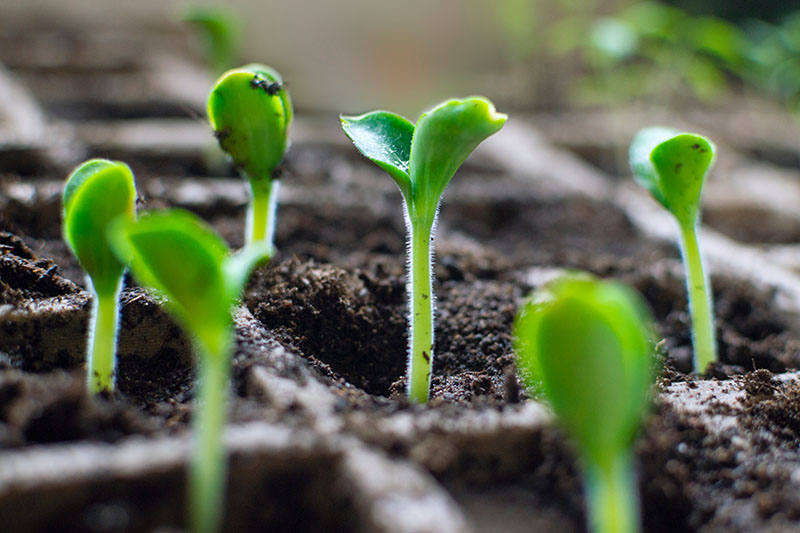
First, take care when planting, and make sure your seeds are planted no more than an inch deep.
At planting time, make sure to work plenty of organic matter into the soil.
Also, be sure you’re sowing seeds at the right time. Zucchini seeds won’t germinate if it’s too cold.
The soil needs to be above 60°F for seeds to sprout. Starting seeds indoors and using a heat mat can give them a healthy start, with conditions just right for germination.
Watch your water. You want the soil to be consistently moist, but not soggy. It should never be allowed to dry out completely.
If you’ve covered all these bases and you’re still not seeing seedlings, it could be damping off.
Damping off is caused by a variety of types of fungi – most commonly Pythium, Rhizoctonia, and Fusarium species.
Make sure you’re buying fresh seeds from a reputable seller. Once you’ve purchased your seeds, store them in a cool, dark place.
Both heat and light can reduce germination rates or even sterilize seeds. Then, be sure to start with fresh, sterilized seed starting soil.
If your plants succumb to damping off, with any luck, you will still have time to start a new crop this season.
If you’re direct-sowing seeds, dig a 9-by-9-inch pocket into the soil, and fill it with sterilized seed starting mix.
2. Seedlings Fail to Thrive
You’ve managed to get your seeds to germinate, but now your little seedlings aren’t looking so good.
They may appear stunted or discolored, or like they’ve been soaked in water. You might even notice a cotton-like growth on the soil. You’re likely dealing with damping off.
Cause
Damping off in seedlings is caused by the same fungus or mold – typically Pythium, Rhizoctonia, and Fusarium – that can attack seeds and prevent them from germinating.
Solution
It’s important to keep your tools, hands, and containers clean to avoid introducing any of these pathogens. Also, only use sterile potting soil that you’ve either purchased or sterilized yourself.
It can also be spread by fungus gnats, so either cover seedlings, or keep a close eye out for tiny bugs flying around your plants. If you see them, use yellow sticky traps to capture them.
Learn more about damping off in this guide.
3. Leaves Curl or Become Deformed
When zucchini leaves start to curl or become otherwise deformed, the first thing you should look for are aphids.
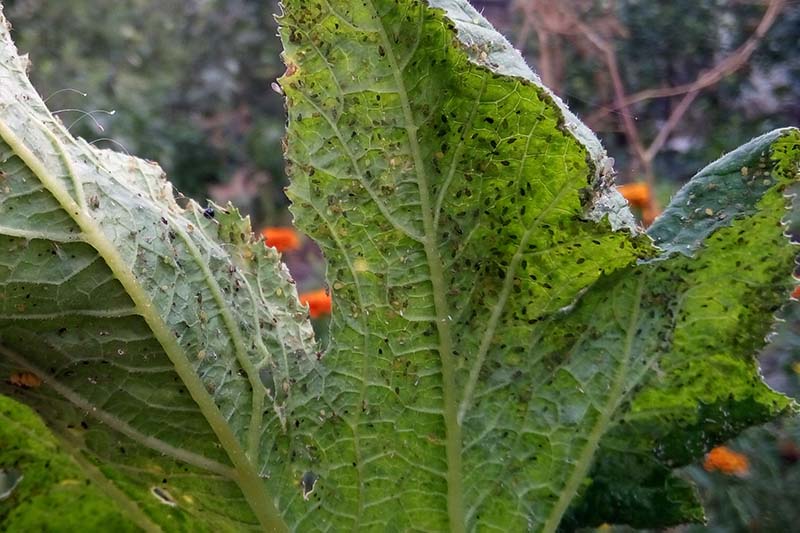
But you may notice ants on your plants first, if aphids are present. The ants like to feed on the honeydew that aphids leave behind.
Cause
When it comes to these pests, it would be easier to list all the plants that aphids don’t attack. Zucchini is one of the plants they particularly love.
Aphids are tiny, pear-shaped, yellow, pink, brown, gray, green, or black bugs that congregate in groups on the undersides of leaves.
They suck the sap out of the stems and leaves, causing stunted growth and deformity.
Solution
The first step in getting rid of these pests is to blast your plants with a strong spray of water from the hose. Often, if you knock aphids loose, they might not survive the deluge or they’ll move on to other plants.
Next, try spraying plants with a 1:10 solution of dish soap and water. Do this once a day for two weeks.
At the same time, try introducing ladybugs or green lacewings to your garden. These beneficial insects love to munch on aphids.
Finally, if your plants are still struggling, apply a neem oil spray every two to three days for two weeks. You can also use insecticidal soap.
Read more about battling aphids in the garden here.
4. Leaves or Fruits Are Mottled or Distorted
Do your zucchini plant’s leaves look kind of funny?
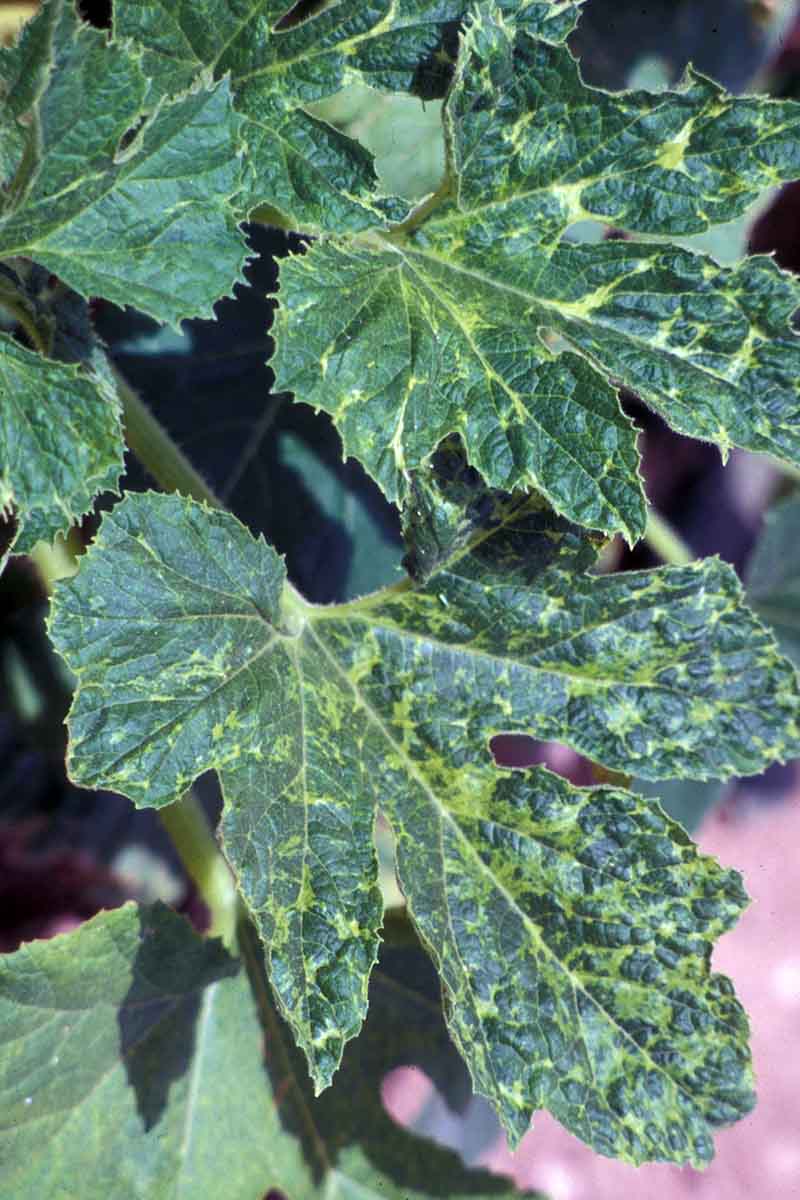
They might be distorted or unusually small. Or maybe they have serrated edges or dark green blisters.
Eventually, any fruits that form will be stunted and deformed as well.
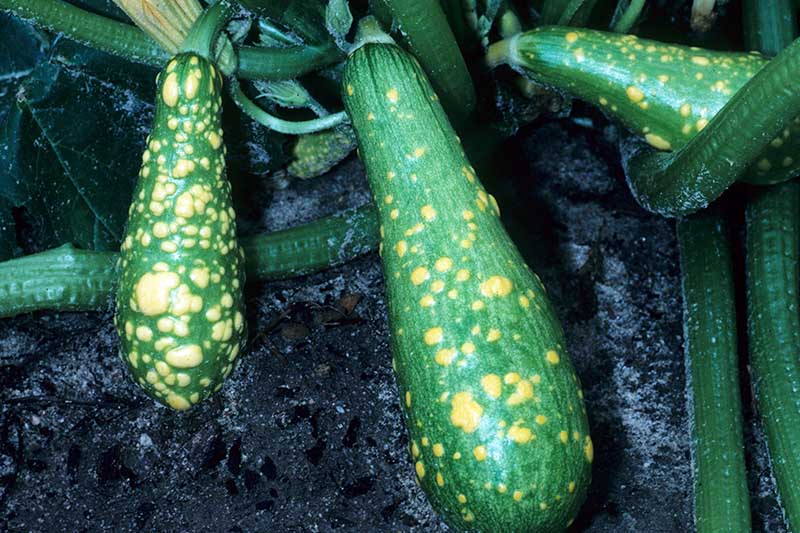
Bad news. It’s likely zucchini yellow mosaic virus (ZYMV).
Causes
Mosaic virus can be contracted in several ways:
- It can be carried in seeds, which is why it’s important to buy from reputable vendors.
- Aphids can carry it, so keep those little pests out of your garden.
- It can also be spread by you, if you use a tool in one part of the garden and then use it in another part without sanitizing it first.
Solution
Once your plants have mosaic virus, unfortunately there’s nothing you can do. Pull up the plant and destroy it. Don’t add it to your compost. Wash your tools well, and try again next year.
Since the virus can overwinter in weeds in the soil, make sure to clean up your garden bed at the end of the year. To be safe, you may consider planting in a different location.
There is one potential solution, however. If this disease strikes early in the season and you live in a warm climate, you may still be able to get another crop in the ground in time to produce a harvest.
In the future, always be sure to sanitize your shovels, rakes, and clippers between uses. Plant resistant zucchini cultivars, and keep aphids at bay.
5. Parts of the Plant Are Wilting
If part of your zucchini plant is growing as happy as ever while other random sections are wilting, you likely have a pest problem on your hands.
Causes
The larvae of the squash vine borer, Melittia cucurbitae, burrow into the stems of plants such as squash, gourds, pumpkins, and zucchini.
These little pests look like fat, white worms with brown heads, but you’ll only spot them if you slice open an infested vine.
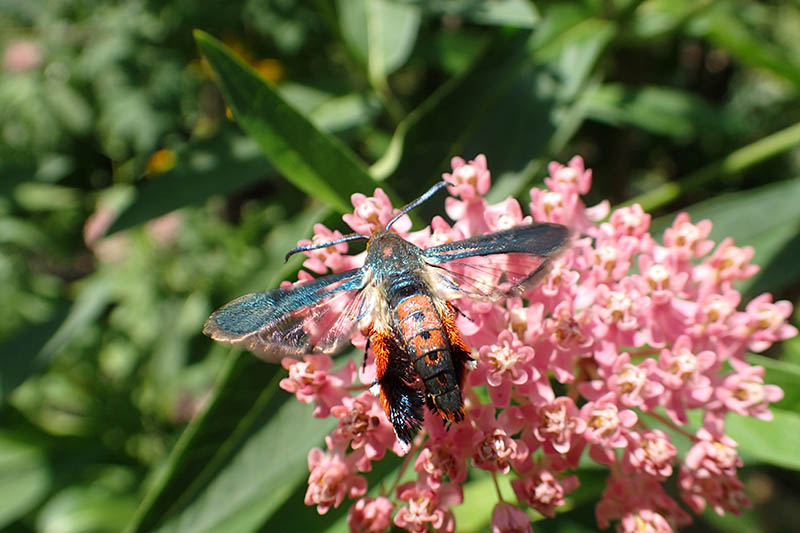
You can also look for the adults, which are wasp-like moths with black bodies and red markings.
If you have an infestation of this pest, random leaves will begin to wilt. You may see green or yellow droppings that look like sawdust around your plants.
Squash bugs, Anasa tristis, are another pest that can cause wilting leaves. Typically, these bugs cause other, more obvious damage, like ragged holes and yellow or brown spots on the foliage.
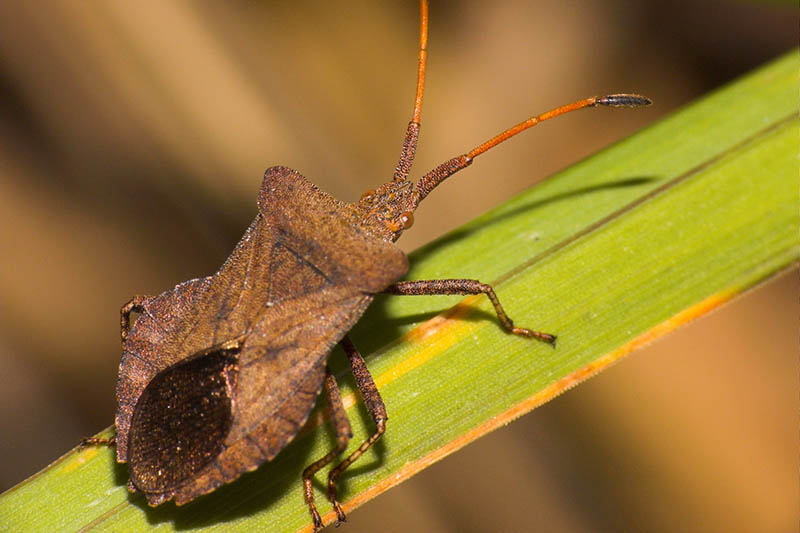
Squash bugs look a bit like stink bugs. They’re over 1/2 inch long and brown or gray in color. They have wings, but they prefer to walk around on plants instead.
You could also have cucumber beetles, Diabrotica undecimpunctata. These black and yellow bugs are about 1/4 inch long with dark heads.

In addition to causing leaves to wilt, they can stunt plant growth and reduce fruit yields.
Solutions
I find the best way to tackle vine borers is to sprinkle diatomaceous earth around plants. You will need to reapply it every time it rains or after your plants are watered.
You can also trap the adults with yellow sticky traps, or go outside with a flashlight at night and nab them.
If that fails, it’s time to break out the Bacillus thuringiensis. For best results, this beneficial soil-borne bacteria needs to be applied when the eggs are hatching, otherwise the larvae will burrow into the vines where the bacteria can’t reach them.
It’s usually too late if your leaves are already wilting, however. But if you know these pests have been a problem in the past, get a jump-start on them next year and apply Bt as a preventative measure.
You can read more about using Bt for pest control in the garden in this article.
Squash bugs are a formidable foe. Once you have an infestation of adults, I’m not going to lie, you have a challenge ahead to get rid of them. That’s why early detection is key.
Keep a diligent eye out as your plants mature. The first thing you’ll see, if you look carefully, are brown clusters of eggs. Wipe them off of your plants and crush them.
If you find adult squash bugs in the garden, place cardboard on the ground around plants and leave it out for one night. The bugs will congregate underneath it.
The next day, grab the cardboard and crush it between two flat surfaces, wrap it in a plastic bag, and dispose of it in the garbage.
You can also use pesticides containing permethrin, carbaryl, bifenthrin, or esfenvalerate, though this works best right around the time the eggs are starting to hatch.
Be sure to avoid spraying your plants with insecticides once the fruits form.
To tackle cucumber beetles, use yellow sticky traps or just go outside and vacuum your plant. It sounds weird, but it works.
You can also put on rubber gloves and coat your hands in petroleum jelly. Then, go outside and wipe the bugs off your plants.
To prevent cucumber beetles, you can cover seedlings with floating row covers. But if you do this, you’ll need to manually pollinate your plants, or remove the covers for a few hours a day so pollinators can do it for you.
Be sure to check out our guide to identifying and controlling zucchini plant pests.
6. The Entire Plant Wilts
If you step outside to check on your garden, only to find that your entire zucchini plant looks decidedly wilted, there could be a few problems that you’re facing.

One of these is totally fixable. The other… not so much.
Causes
Bacterial wilt is caused by a bacterium, Erwinia tracheiphila, that causes plants to wilt and eventually die. You may notice leaves turning yellow and then brown before they wilt, or this may happen after.
If the entire plant is wilting, this can also be a sign that it isn’t getting enough water. So you will need to do some careful sleuthing to determine what’s what.
Solutions
Try giving your plant a good soak with the garden hose and cross your fingers that it perks up. If not, you probably have a case of bacterial wilt on your hands.
At that point, there isn’t much you can do.
In the future, keep an eye out for cucumber beetles. These little pests spread the disease, so managing them is key.
7. Leaves Have Yellow Spots Turning Brown
If your zucchini leaves develop little yellow spots, you may have squash bugs. You can be especially sure this is the case if those spots start to turn brown.
Cause
Squash bugs, as you may have guessed and as described previously, are pests that feed on plants in the squash family.

They will suck the sap out of your zucchini plants, sometimes causing irreparable damage. They can kill young plants, and reduce yields for mature ones.
As mentioned earlier, they’re light brownish-gray as adults, and the females lay egg clusters in orderly rows on the undersides of leaves.
Solution
As mentioned above, squash bugs are a challenge to eradicate from the zucchini patch. Follow the steps outlined above in the section on plants that are wilting to deal with them.
8. Leaves Have a Powdery Coating
Nearly every gardener has run into powdery mildew at one point or another. If you haven’t already, just give it time. It’s my arch nemesis when it comes to growing zucchini.
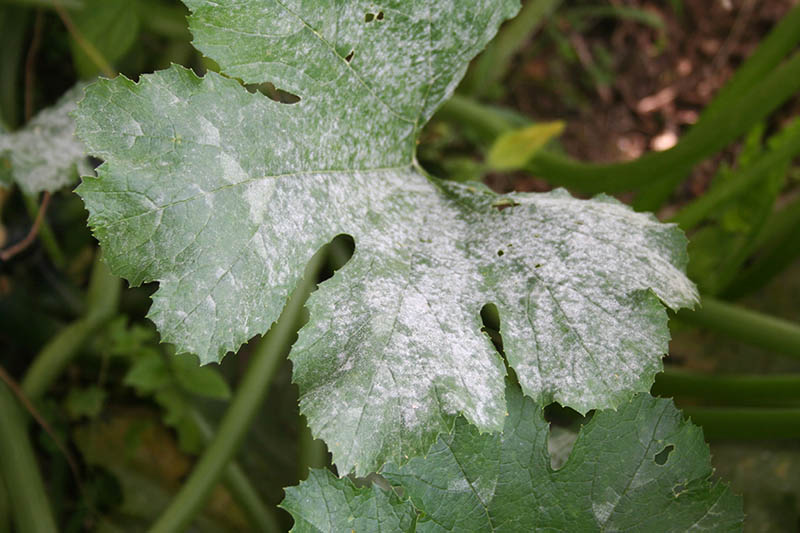
You’ll notice white, powdery spots form on the leaves, and those spots will eventually spread until the entire plant looks like it has been dusted in flour.
A little powdery mildew isn’t a big deal, but if it spreads, it can kill the leaves of the plant and reduce the final fruit yield.
Cause
This common disease is caused by a fungus, Podosphaera xanthii, and usually shows up in mid- to late summer because it likes warm, humid weather.
This fungus attacks plants that are crowded and have poor air circulation.
It can travel on the wind, so if plants nearby have it, it’s likely to spread.
Solution
Once you find your plants have it, the most surefire way to tackle powdery mildew is to apply a sulfur-based fungicide according to the manufacturer’s directions.
You can also use neem oil or a biological fungicide like CEASE, available from Arbico Organics.
Next year, keep your plants well-spaced, and keep your garden weed-free. Keep a close eye on your crops, so you can tackle the problem before it spreads, if powdery mildew rears its ugly head again.
Also, avoid over-fertilizing. Only use the minimum amount recommended.
9. Flowers Fall Off the Plant
You head outside to check on your thriving zucchini plant, only to discover that the blossoms that looked so healthy yesterday have fallen to the ground.
Don’t fret, it’s probably not a total disaster.
Causes
The most common cause of flowers falling off the vine is that they are male blossoms that have already done their job.
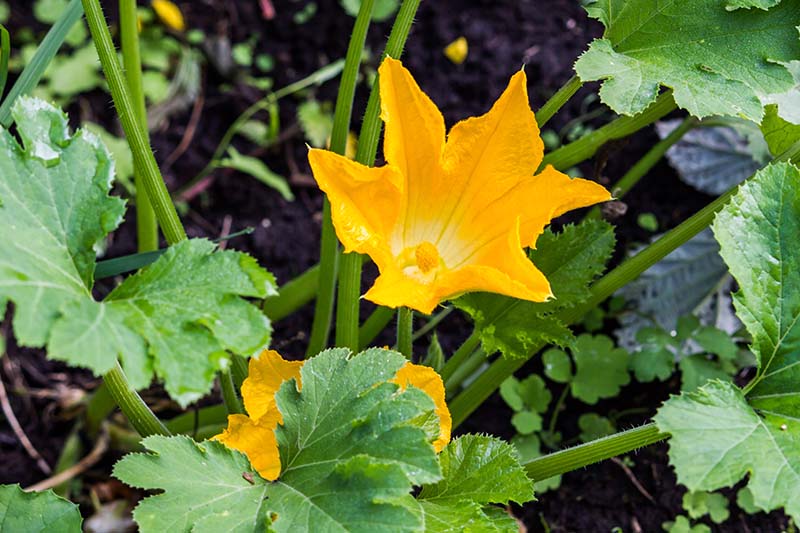
Zucchini plants are monoecious, meaning they have both male and female flowers. After the male releases its pollen, it drops to the ground.
Sometimes, courgette plants form an early burst of male flowers before the female blossoms develop, so even if all the blossoms seem to be falling, it’s likely not a problem.
However, poor pollination can also cause blossoms to fall. What’s happening is that the blossoms aren’t being pollinated well enough, so the plant decides to drop its blossoms and try again.
If this is the case, try hand pollinating if and when you get a second burst of blossoms.
Solution
It’s hard to tell the difference between what might be evidence of poor pollination versus a normal pattern of male flowers falling off.
But if you see bees and butterflies visiting your plant regularly, it’s probably the latter.
You can also peek at the fallen flowers and see if there is a stigma present or not. If there is, that means your female flowers are falling, and you should get to pollinating the flowers by hand.
We’ll cover manual pollination in the section below and we go into more detail about zucchini blossom drop in this guide.
10. Flowers Form, But No Fruits
If you aren’t getting fruit even though your plant grew flowers, you probably have a pollination problem.
Cause
As mentioned earlier, zucchini plants produce both male and female flowers.
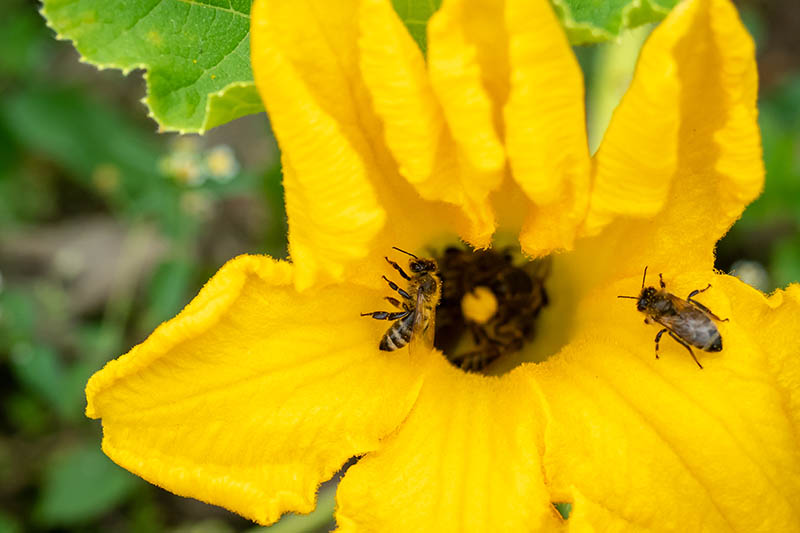
A pollinator carries the pollen from the male to the female blooms, and a little while later, a baby zucchini is born.
If the flower doesn’t get pollinated, then you don’t get fruit.
Solution
If pollinators don’t visit your plant, the best solution is to take a cotton swab or small paintbrush and do the job yourself.
First thing in the morning, head out to the garden. Gather the pollen from a male flower by wiping the anther. You should get a bunch of yellow powder on your swab. Spread it onto the stigma of the female flower.
Re-apply more pollen from a male flower each time you move to a new female flower.
If you did it right, within a day or two you’ll see a thick green bulb form at the base of the female flowers. If you don’t see this happening, do some more manual pollinating.
11. Fruits Have Dark, Sunken Spots or Rot on the Vine
If your fruits start to grow and then suddenly develop dark, leathery spots or look like they’re rotting on the vine, they probably have blossom end rot.
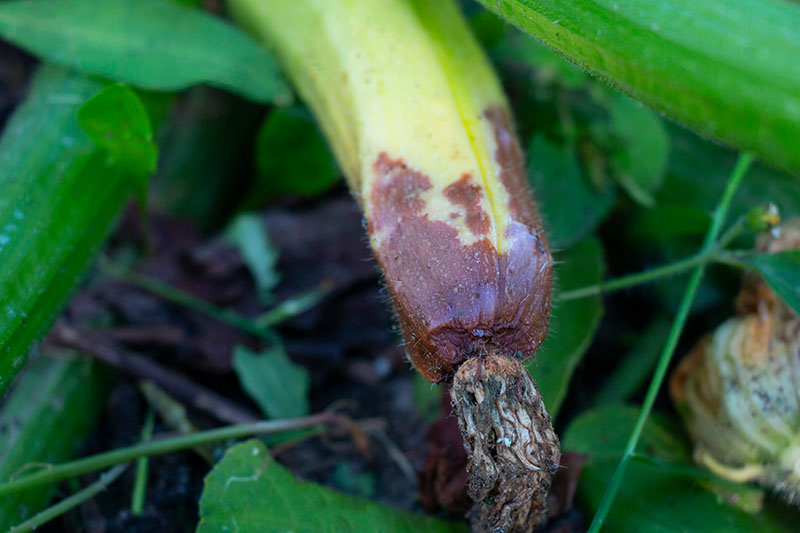
Blossom end rot is caused by a calcium deficiency, but tossing a bunch of eggshells in the garden after you notice signs of a problem isn’t going to help.
Learn more about troubleshooting blossom end rot here.
Cause
Supplementing your plants with calcium after the fruit has already formed and started to show signs of a deficiency won’t work.
This is because calcium deficiency is often caused by a lack of water in the soil, which transports calcium into the plant.
Solution
Once fruits start to rot, it’s too late to help them. But you can prevent this disease from destroying future fruits on the same plant if you have a long enough growing season.
Once plants are already in the ground, the key is water – not adding calcium. You need to give your plants the right amount, on a consistent basis.
The soil should never be allowed to dry out completely beyond 2 inches deep.
You don’t need a fancy tool to gauge this, just stick your finger into the soil, 2 inches down. If it’s dry, your plant isn’t getting enough water.
Zucchini needs about an inch of water a week, and you should be watering at the base of the plant rather than overhead to avoid promoting the onset of other diseases.
You can head this problem off in the future by doing a soil test before planting.
If you discover a calcium deficiency, amend the soil with calcium sulfate or calcium chloride, following the manufacturer’s directions.
Some gardeners also like using dried, crushed eggshells for additional calcium. Just add some to the planting hole before you add your seeds or seedlings.
You should also adjust the pH of your soil to around 6.0-7.5, which is what zucchini plants prefer.
You’ll still need to keep your plants well-watered, however. All the calcium amendments in the world won’t work if the water isn’t transporting it into the plant.
Don’t Let Zucchini Problems Get You Down
If you garden long enough, you’re likely to run into problems at some point. But they don’t have to get you down – it’s all just a part of the process.
Make things easier on yourself by heading out to your garden every day to check on your plants. Look under the leaves for insect eggs, poke your finger in the soil to test for moisture, and look around for bugs – both the good ones and the bad ones.
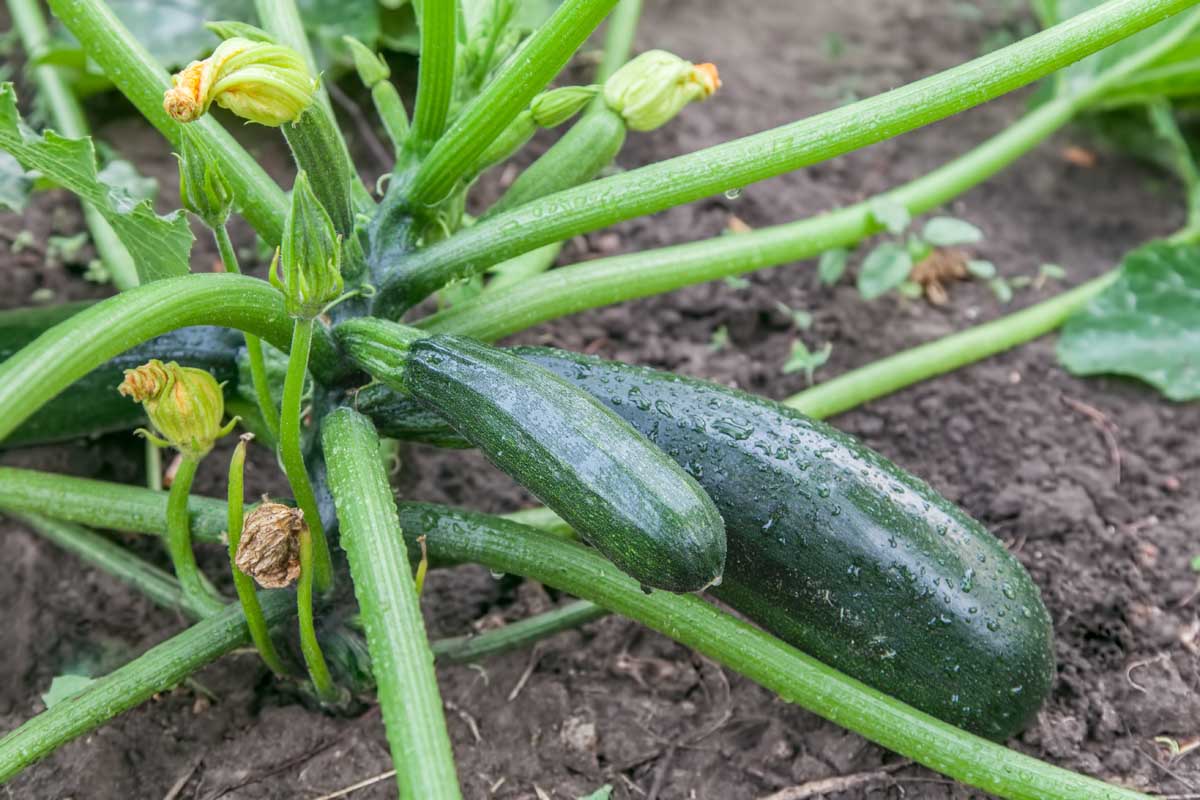
One year, I put my zucchini plant at the very back of my yard because I wanted to let it spread out. It became a sort of out of sight, out of mind situation.
When I did finally go check on my plant, I realized the entire thing had an advanced case of powdery mildew.
I got a few sad fruits that year, but not much else. Learn from my mistakes and keep an eye on your plants.
I’d love to hear if you find this guide helpful or if there’s anything you’ve encountered while growing zucchini that we didn’t cover. Let us know in the comments below!
While you’re at it, we have a few other helpful guides for growing zucchini. Have a look at these articles next:
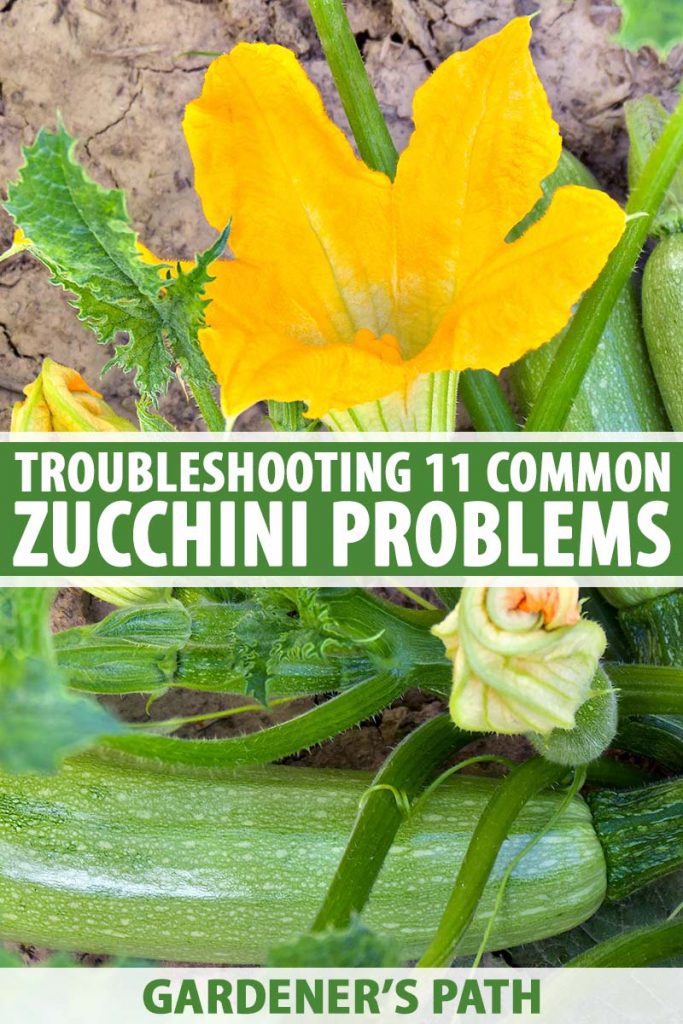
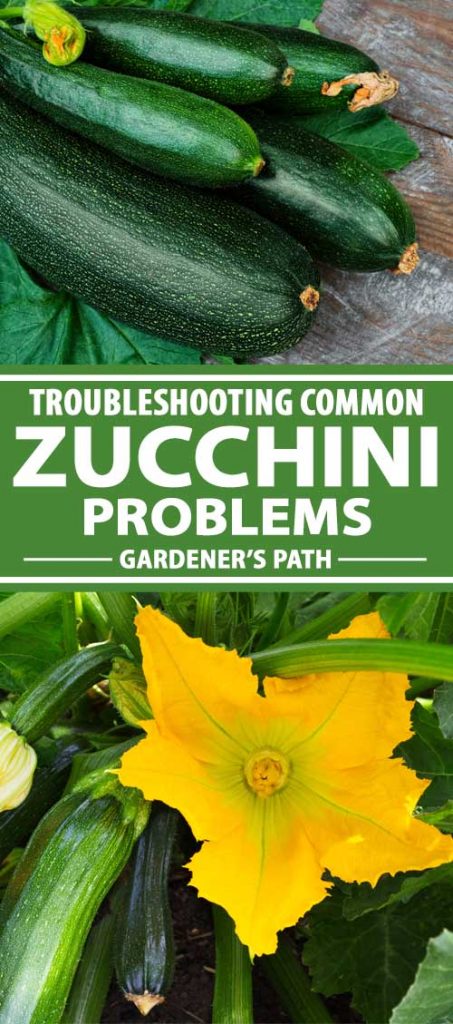

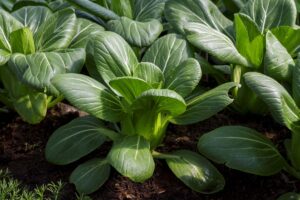
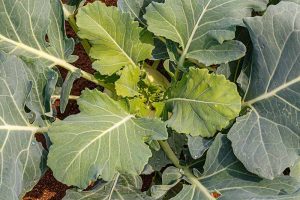
My potted zucchini leaves are getting white marks all over, not looking like mildew. Don’t see any bugs on the leaves. I have attached a photo for you to see. Please let me know what to do so the plant doesn’t die.
Thank you.
I’d be happy to help you figure this out! Unfortunately, I can’t see the image you attached. Can you try uploading it again?
I had powdery mold so I used milk to fight it
Now most of the large fan leaves have started turning this color
Is this a micronutrient deficiency?
Judging by the veining, it does look like chlorosis, which is usually a deficiency in iron, manganese or zinc. In this case, it’s likely manganese or zinc, since it is happening to the older leaves first. A soil test is your best bet to figure out what’s going on.
I’m growing round zucchini for the 1st time. I have round fruit and after the flower dies off, the front shrivels up and falls off. Fruit starts out fine, growing for at least a week when this happens.
Oh dear, no fun. When you say the front shrivels up, are you referring to the place where the blossom was attached? If so, it sounds like blossom end rot. It could also be poor pollination – especially if you’ve had a rainy spring (rain reduces pollinator activity). To tackle that, you might want to do some hand pollinating. Snip off any developing fruit to encourage another round of blossoms. This page can guide you through hand pollination: https://aggie-horticulture.tamu.edu/newsletters/hortupdate/2013/mar/hand-pollinating-squash.html
The vines of my zucchini and yellow squash plants look like they have been cut off, and the small veg that have started just fall off. What causes this and how can I take care it? Picture attached
Usually when entire leaves go missing overnight, it’s some type of mammal having a snack. Rabbits, voles, woodchucks, deer, chipmunks, and squirrels are all likely culprits, though rabbits and deer tend to most often sever plants off cleanly like that. Did you notice any blossoms disappearing during the flowering period? I suspect something has been eating the blossoms as well, which could cause poor pollination (and subsequently, young fruit falling off the vine). If you don’t live in an area where wildlife can access your plant, it could be slugs. That said, did you notice any wilting or yellowing before… Read more »
Good day, my zucchini, yellow and green look healthy. Large healthy leaves and flowering. Noticed fruit growing over a week ago to about 2″. They don’t seem to be growing as quickly as they should. They still look good but growth seems to be stunted. Is there something I could do to help them along.
Hi Darlene! Hard to say exactly why the fruit may be slow – there are a range of things that can cause slow fruit growth. Low temps in the spring, not enough water, too much water, soil that’s deficient in nutrients, or low pollination rates. It can also be disease or pests, but if the plant looks healthy, it’s likely not. The first thing I would check is the amount of water the plant is getting. If the top inch of soil is dry, your plant needs more water. You might also want to do a soil test. Keep an… Read more »
I have mine in containers on a deck. About 50% of the female flowers turn yellow and rot and fall off when they are about an inch long, long before they ever flower. I try to keep them exposed to sunlight as best as possible, by turning containers and trimming larger leaves. The others stay green and are easily hand pollinated, grow and stay healthy. What would cause them to turn yellow and fall off long before they are old enough to open for pollination? It has been damp and cloudy for a bit, here.
Thanks you,
Usually if the female flowers are falling off or not opening, it means your plant is stressed in some way. The plant basically decides that conditions aren’t good enough for reproduction and decides to conserve energy. It sounds like you’re working hard to keep your plants in the sunshine, so if your plants are getting enough sun (6 plus hours a day), check the amount of water they’re getting. Once the top inch of soil dries out, they need more water. If it has been rainy and cloudy, as you say, are your plants getting too much water? The soil… Read more »
Hello, my zucchini plant looks healthy and large as far as the leaves are concerned and is spreading very nice. But as of now i have no flowers at all. Please let me know what could be the problem. Thank you for your time and advise.
Hello, it sounds like your plant is growing nicely – what USDA Zone are you in? Did you have a particularly chilly or cloudy spring? What zucchini variety are you growing? Have you given it any fertilizer? Sometimes an abundance of nitrogen can cause a plant to focus on the leaves rather than forming flowers, so you don’t want to over-fertilize. For now, I would focus on making sure your plant is getting all the water it needs (water once the top inch of soil dries out), and check to make sure it is getting 6 or more hours of… Read more »
My zucchini plant the stem at the bottom of the plant is black it doesn’t look like it is rotten is this normal
It’s hard to say without seeing the actual stem, but typically, a dark or black stem is a sign of trouble. There are a number of things that can turn a stem black, but the first thing I’d look for is a squash vine borer. Look closely at the base of your plant. Do you see any “frass?” It looks a bit like sawdust and its the waste of the larvae working its way through your zucchini. It could also likely be foot rot. Look for the leaves of your plant to start wilting. If this happens, it’s likely rot… Read more »
Zucchini did not blossom at all, plant looks large & healthy; no flowers. Didn’t see that covered above. Thanks
Hi Diane, there could be a number of things going on here. Lack of blossoming can be stress or just a delay due to weather conditions. If you’ve had an unusually hot/cold or rainy spring, your plant could just be behind a bit. Do you have any neighbors with zucchini plants that have blossomed? The next thing I would check is the amount of water your plant is getting. The top inch of soil should just dry out between watering. Did you add any fertilizer this spring? Too much nitrogen can cause plants to focus on foliage rather than blossoming.… Read more »
Hello! My zucchini plants are getting tons of male flowers but NO female flowers. I understand the pollination issue if you have flowers but no fruit, but what would cause the plant to not produce female flowers in the first place? They were planted in late March, so now in July I assumed the plants would be mature enough. Thanks!
It’s normal for zucchini plants to form male flowers at first. Usually, female blossoms will follow within a week or so. Give your plant just a bit more time to start sending out those female flowers. If you don’t see any in two weeks, it could be that your plant is stressed and holding back. Make sure it’s getting enough water while you wait for the female blossoms to follow.